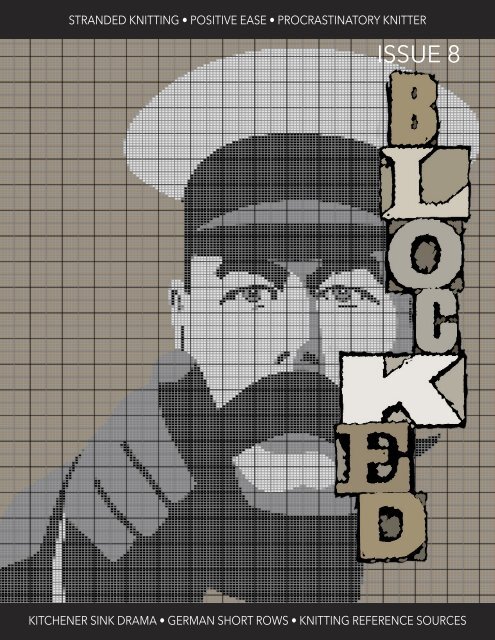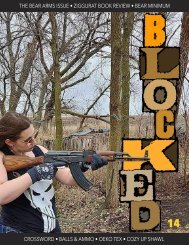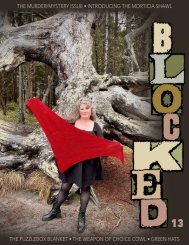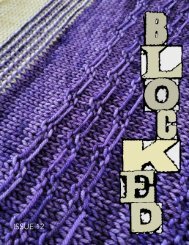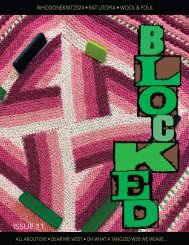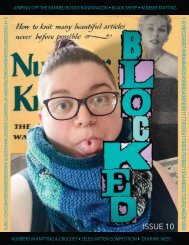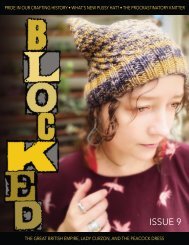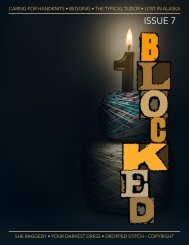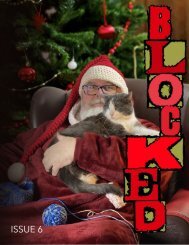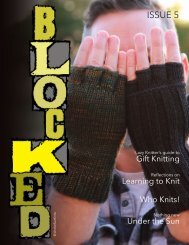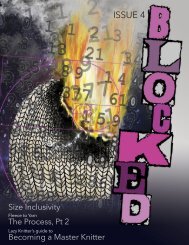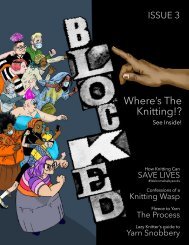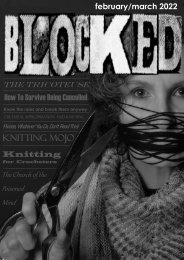BLOCKED_8_FINAL
Create successful ePaper yourself
Turn your PDF publications into a flip-book with our unique Google optimized e-Paper software.
STRANDED KNITTING • POSITIVE EASE • PROCRASTINATORY KNITTER<br />
ISSUE 8<br />
KITCHENER SINK DRAMA • GERMAN SHORT ROWS • KNITTING REFERENCE SOURCES
Unless otherwise indicated the information,<br />
articles, artwork, patterns and photography<br />
published in <strong>BLOCKED</strong> Magazine are subject<br />
to copyright ©2023 <strong>BLOCKED</strong> Magazine.<br />
All rights reserved.<br />
<strong>BLOCKED</strong> Magazine permits the online<br />
distribution of the magazine in its entirety.<br />
Distribution of any of the contents of this<br />
magazine are for purposes of sale or resale<br />
is strictly prohibited.<br />
Editor<br />
Neil of Uknitted Kingdom<br />
For all enquiries:<br />
blockedmagazine@gmx.com<br />
Cover Illustration<br />
Uknitted Kingdom<br />
Illustrations<br />
Uknitted Kingdom<br />
Contributors:<br />
Khgknits<br />
Denise Pettus<br />
Land O’Lakes Girl<br />
The Laziest Knitter<br />
Uknitted Kingdom<br />
Patterns:<br />
Uknitted Kingdom<br />
Proofers:<br />
Cézanne Pellett<br />
Laura Neubauer<br />
Denise Pettus<br />
Design and layouts:<br />
BS Studio
Dear Readers,<br />
This issue is a little late, which isn’t entirely accidental. I deliberately<br />
wanted to avoid an April Fool’s release date. The “K” Word article<br />
alone would never be taken seriously if released on April 1st!<br />
You’ll notice there are no patterns in this issue (except for the dishident). Never fear; we have<br />
4 hats, 2 cowls, and a crochet blanket, amongst others, all waiting in the wings and almost<br />
ready to publish in issue 9. Testing has been completed and we’re just awaiting photos and a<br />
couple of edits.<br />
You’ll find the list of affiliate testers has been removed. You can read about why and how<br />
to remain a Blocked test knitter/crocheter in “The Truth Will Set You Free.”<br />
So, what has been happening behind the scenes? I was interviewed by Maree on Reality<br />
Check Radio (RCR) https://realitycheck.radio/ (this may have been aired by the time you<br />
read this issue) and I attended Keri Smith’s Deprogrammed birthday episode<br />
https://www.youtube.com/live/IUGByHY8z44?feature=share where I met some interesting<br />
people who I’m hoping to invite onto the Blocked Magazine YouTube channel.<br />
Tabitha (Murderknits) and I held a livestream to talk about the 1997 Louise Woodward trial<br />
(more livestreams coming soon). You can watch all 17 episodes currently on YouTube here<br />
https://www.youtube.com/@blockedmagazine2859/streams or on Rumble here<br />
https://rumble.com/c/c-2235334<br />
I’ve also been kept busy studying Japanese knitting patterns for an upcoming project.<br />
Watch this space for more details.<br />
All that’s left to say is enjoy this issue!<br />
Yours faithfully,<br />
Neil<br />
3
The Lazy Knitter’s Guide to<br />
Stranded Knitting<br />
by the Laziest Knitter<br />
There are few knitting skills that have the wow-factor<br />
that stranded knitting can have. When you combine a<br />
thoughtful palette with beautiful arrangements of patterns<br />
in skillful hands, the result can be breathtaking.<br />
However, if you have ever attempted a Fair Isle sweater<br />
and ended up with a muddy mess of wonky stitches that<br />
is 5 sizes smaller than you meant, you are not the only<br />
one.<br />
With stranded knitting, you must consider many<br />
things all at once. Color placement and contrast will<br />
make or break the outcome as much as your tension<br />
and technique. Yarn management<br />
and hold can affect the way the<br />
stitches appear and dictate how<br />
tight your floats are across the<br />
back of the work. If you’ve been<br />
struggling to produce stranded<br />
knitting that looks like it could<br />
have stepped off the pages of an<br />
Alice Starmore book, perhaps the<br />
following tips and tricks can get<br />
you there. A bit of footwork up<br />
front can save you heartache later.<br />
Fair Isle or Stranded Knitting?<br />
If you are going to dive deep into the stranded knitting<br />
rabbit hole, it’s best to get the lingo straight. While<br />
many knitters use “Fair Isle” and “stranded” knitting interchangeably,<br />
knitting purists will let you know that<br />
there is a distinct difference between the two. Stranded<br />
knitting refers to colorwork knitting that is created by<br />
carrying different colored yarn along a row of knit<br />
stitches. The carried yarn creates strands or floats along<br />
the back, hence the name “stranded” knitting. Fair Isle<br />
knitting refers to a style of stranded knitting that originates<br />
from the island of Fair Isle that lies north of Scotland.<br />
Fair Isle uses only 2 colors of yarn per row of<br />
knitting, has short floats, and uses high contrast yarns<br />
with a recognizable set of Fair Isle patterns. To be safe, I<br />
refer to most of my stranded knitting as stranded knitting<br />
and avoid calling it Fair Isle unless I know for sure<br />
that the pattern I’m using originated from the region,<br />
lest I be shamed for some sort of “appropriation.”<br />
4<br />
Start Strong<br />
The first place where<br />
stranded knitting can go<br />
horribly wrong is in yarn<br />
selection. In order to be able to<br />
see the pattern, contrast between<br />
colors is required. While high contrast<br />
of value (lightness/darkness)<br />
is the easiest way to make a pattern<br />
discernible, contrast in color<br />
can also be effective. Entire books<br />
have been written about color<br />
theory and color palettes, but a<br />
beautiful and harmonious color<br />
selection will be lost if there isn’t<br />
enough contrast and your pattern<br />
isn’t readable.<br />
It gets even trickier when you<br />
start reaching for those variegated<br />
and speckled yarns. The variance<br />
in the yarns can blend the edges<br />
of the motif into the background<br />
color. Selecting variegated and speckled hanks that are<br />
mostly all dark or all light and of one color family will<br />
help your pattern’s visibility.<br />
If you are unsure about the contrast in your yarn selections,<br />
take a photo and turn the saturation all the way<br />
down. The resulting image will give you the exact<br />
amount of value contrast that you have.<br />
Continued on next page...
Lazy Knitter Continued...<br />
Loosen Up<br />
Many of my first stranded knitting projects had tight<br />
floats leaving the fabric puckered and the garment far<br />
too small. With regular knitting, it’s considered good<br />
practice to have tight(ish) tension and any loose floats<br />
between stitches are considered ugly ladders. But with<br />
stranded knitting, you must overcome this tendency<br />
and let the strands that occur when you drop a color<br />
and then pick it back up float loosely across the stitches<br />
of another color. Try to get a feel for exactly how loose<br />
to leave the floats. In my experience, it’s difficult to<br />
leave them too loose.<br />
It helps to spread the stitches apart at the color and<br />
not pull the first stitch of the color change tight. Pulling<br />
this stitch tight acts like a drawstring and puckers the<br />
fabric. It takes some practice to get a feel for how loose<br />
you need to leave the strands and stitches.<br />
Starting with small projects like a hat or mittens is a<br />
great way to get familiar with the correct tension of<br />
stranded knitting. If you continue having difficulties<br />
with tight floats, you can try knitting the piece inside<br />
out. This helps keep the floats longer as they are skimming<br />
the outer circumference of the piece. You could<br />
also try using larger needles than usual, so some of the<br />
slack in the stitches gets pulled into the floats when<br />
you put on the garment.<br />
With stranded knitting, blocking does help even<br />
out tension and relax some puckering. However, blocking<br />
cannot overcome super short floats.<br />
Color Dominance<br />
To add to the complexity of stranded knitting, the<br />
way you carry the yarns influences the way the stitches<br />
appear. One color will usually appear a bit more prominent<br />
than the other (called color dominance.) As you<br />
are knitting along, take a look at the back of your work.<br />
You will notice that one color has floats that sit on top<br />
of the floats of the other color. The color with the top<br />
floats appears a bit smaller than the other from the<br />
front. It’s a subtle difference but one worth your attention.<br />
It’s best to have the main color in the dominant<br />
position and the contrast or background color in the<br />
secondary position. The hold you have on the yarns<br />
dictates the dominance of the colors.<br />
2 handed hold:<br />
The yarn in the left hand<br />
will be the dominant color.<br />
Side note: This hold produces<br />
the most even tension as the<br />
uptake difference between the<br />
colors does not affect tension<br />
since they are separated. One<br />
yarn doesn’t tug the other<br />
yarn along through friction.<br />
1 handed hold:<br />
The yarn held to the left<br />
will be the dominant color regardless<br />
of whether the yarn is<br />
carried on the right hand or<br />
the left. Side note: This hold<br />
can create tension issues if<br />
there are long stretches of one<br />
color because of the uptake<br />
difference in the yarns. The<br />
yarn that is most used tugs along the other yarn when<br />
they are kept in the same hand.<br />
Drop and pick up hold:<br />
The ball of yarn set to the left of the other will be<br />
the dominant color. It’s easy with this hold to move the<br />
yarns back and forth which could result in neither yarn<br />
dominating throughout the piece.<br />
Fake It ‘til You Make It<br />
If carrying 2 yarns along your work seems too difficult<br />
for you at the moment, but you are in love with the<br />
look of stranded knitting, you could consider mosaic<br />
knitting. With this technique, you knit only one color at<br />
a time, slipping the stitches of the other color. You ultimately<br />
must knit each row twice (once for each color)<br />
to produce your pattern, but some people find it easier<br />
to do this than manage 2 strands of yarn at a time.<br />
As with all new things, practice makes perfect. My<br />
history with stranded knitting started with tangled<br />
yarns, puckered fabric and unreadable designs. However,<br />
it evolved into being able to carry 3 yarns and<br />
producing beautiful patterned flat fabric. Learning results<br />
where there is discomfort and even failure. Getting<br />
comfortable with being uncomfortable is how we<br />
find success.<br />
5
By Denise Pettus<br />
Positive Ease<br />
We all love our real time friends who knit - talking<br />
about patterns, new skills, yarns, and notions, and knitting<br />
together while we share stories of our lives. For<br />
those of us who live in rural areas or locations where<br />
the nearest LYS is an hour’s drive, finding one friend<br />
who knits makes that one knitter a cherished jewel.<br />
When I eagerly registered last spring for the Knitty<br />
McPurly Cozy Mountain Retreat, I envisioned making<br />
new knitting friends at the event. But I had no idea of<br />
the camaraderie, kindness, enthusiasm, and friendships<br />
that would develop among 87 knitters over the threeday<br />
weekend at Lake Junaluska’s historic Lambeth Inn<br />
in the North Carolina (USA) mountains.<br />
The retreat was Jan. 26-29, and from beginning to<br />
end it was filled with smiles, laughter, encouragement,<br />
help, and learning.<br />
Devin Ventre, designer/indie dyer and creator of<br />
Knitty McPurly, initially pitched the retreat idea in the<br />
winter of 2022 on her popular YouTube podcast. She<br />
envisioned a retreat where those who taught the<br />
classes also were attendees of the event instead of<br />
being “knitting royalty.” And that’s what<br />
she pulled off at her retreat - those who<br />
taught the classes were the same<br />
people you sat with to learn in other<br />
classes, the same ones you knit with in<br />
the hotel lobby area, and sat with at<br />
breakfast, lunch and dinner. Devin herself<br />
circulated the three-day event - dining<br />
with various new friend groups,<br />
admiring the plethora of colorwork<br />
sweaters (many her own designs), attending<br />
mass, and chatting in the<br />
rooms designated for shopping<br />
the vendors.<br />
To say that new friends were<br />
made is an understatement - this was an event where<br />
everyone was your friend. If you were alone, there was<br />
no hesitation in approaching a group who sat chatting<br />
and knitting in the lobby. You were one of them, and<br />
you were welcome. To say that the retreat accomplished<br />
what Devin envisioned doesn’t do it justice -<br />
because it accomplished that and so very much more.<br />
The retreat drew attendees<br />
from Florida,<br />
Texas, Washington, Illinois,<br />
Georgia, Wisconsin,<br />
Ohio, West Virginia,<br />
Virginia, and Colorado<br />
to name a few. It was<br />
amazing to see so many<br />
people from different<br />
areas of the country<br />
come together<br />
over a love for their craft, exchange ideas, and<br />
develop friendships.<br />
Devin built a three-hour block of time into<br />
the retreat schedule for attendees to make their<br />
way down the highway to visit Black Mountain<br />
Yarn Shop - a shop that has gained a global following<br />
as it hosts events with some prolific designers<br />
such as Stephen West and Andrea<br />
Mowry, who had been at the shop the previous<br />
weekend.<br />
Continued on next page...<br />
6
Positive Ease Continued...<br />
Each class lasted 1:30-2 hours and included:<br />
- Brioche by Cheryl Beckeridge of https://www.wiseowlknits.com<br />
- Altering Patterns to Fit Your Needs taught by Holly<br />
Armstrong of Mystery Mouse Yarn Co. (she has an awesome<br />
Etsy shop)<br />
- Intarsia 101 taught by Anne Pinkava, co-host of Politically<br />
Incorrect Knitters on YouTube<br />
- Sweater Design by Devin Ventre of https://knittymcpurly.com<br />
- Freeform Art Weaving with Karista Low<br />
of https://sweetmountaincrafts.com<br />
I must admit - learning intarsia and doing<br />
freeform art weaving weren’t very high on<br />
the list of skills I wanted to learn. Thanks to<br />
Anne’s instruction, I now have my eye on<br />
some intarsia throw pillow patterns. Thanks<br />
to Karista giving the class permission to<br />
make the weavings their own, I look around<br />
my craft room and see fibers, ribbons, and<br />
cloth that can one day be used to help my<br />
grandchildren make their own freeform weaving. Thanks<br />
to Holly’s class, I’m not afraid to include stripes in a solid<br />
sweater pattern, split the hem or make other pattern alterations<br />
to get the desired garment. Since taking Cheryl’s<br />
class, I have no fear of choosing a project that<br />
includes the mysterious brioche. But I must apologize to<br />
Devin - because I probably will never be brave enough to<br />
pick a favorite shirt from my closet and attempt to design<br />
a sweater in the same style. I have 53 years of knitting behind<br />
me, and that isn’t enough for me to undertake designing<br />
a garment!<br />
Let me share that as an empty nester and introvert<br />
who lives very rural and has only one real time friend who<br />
knits, in the days leading up the retreat I was met with<br />
some emotions - anxiousness and fear of acceptance,<br />
questioning my ability to socially interact, and doubting<br />
my skill and decision to attend.<br />
When I travel to Washington I can reconnect with Rachel<br />
and Carissa; in Georgia I can catch up with Susan; in<br />
Florida I can make new memories with Sandra; in Chicago<br />
I can count on Beth. All of my fears were unfounded<br />
in the days preceding the retreat. Thanks to Devin and<br />
the Knitty McPurly Cozy Mountain retreat, I have 87 new<br />
best friends who knit. And I look forward to getting together<br />
with them again for the next retreat.<br />
7
By Land O’Lakes Girl<br />
The Procrastinatory Knitter<br />
Every now and then I haul out part of my yarn<br />
stash to admire and caress it. The skeins lay there in a<br />
twisted heap waiting to be turned into something<br />
magical, but I usually just put them all back after a<br />
while. “Another day, my lovelies,” I think to myself as I<br />
shut off the light and walk away.<br />
This weekend, I pulled out a bit of my extensive<br />
yarn collection and admired it. I really do have lots of<br />
great skeins. Some are from independent dyers, some<br />
are from craft stores, but they are all deserving of<br />
being used in something wonderful.<br />
When admiring time was over, everything was<br />
carefully put back in boxes and bins, stacked in the<br />
closet, and left in the dark. The closet doors were<br />
closed, the room exited, and I wondered, “What in the<br />
world am I going to knit next?”<br />
We have all been there, excitement building over<br />
our new purchases, bought with the best of intentions,<br />
only to be stumped once that fluff mail actually<br />
arrives. I really do admire people who buy with purpose.<br />
They know exactly what they are going to do<br />
with nearly every purchase before they swipe that<br />
credit card. They see a pattern and say, “I am going to<br />
knit this item,” buy the correct number of skeins, then<br />
set to work. The finished product doesn’t always work<br />
- perhaps the yarn is too busy for the stitch pattern,<br />
but they complete it. They choose, they work, they accomplish!<br />
They are already deciding what to knit once<br />
the current project is completed. They have no creative<br />
slumps. If they do, they hide it well because their<br />
social media pages are always brimming with beautiful<br />
things.<br />
My admiration extends to those who create patterns,<br />
too. My brain does not think that<br />
way, and I don’t have the patience or<br />
attention span to work things out, so<br />
my hat is off to everyone who has<br />
created a pattern because I certainly<br />
never could, and I don’t need to reinvent<br />
the wheel. I’ll leave that to those<br />
who are best suited and will honor<br />
them by knitting their items. Eventually.<br />
Some of us are collapsing under<br />
the avalanche of our beautiful fibers, but<br />
don’t know what to do with any of it. There<br />
are so many fantastic options, how does a person<br />
choose? How do we decide what needs to be created<br />
next, especially when we enjoy the fine art of procrastination?<br />
And why worry about it right now? The beautiful<br />
fiber will still be there tomorrow, right where we left it.<br />
Who says it needs to be knitted right now? This indecision<br />
and putting off can lead to a creative doldrum,<br />
to which I fall prey more often than I should<br />
ever really admit.<br />
Part of the problem with my chronic creative funks<br />
is that I live in an area where it’s not really practical to<br />
wear knitted items. Too hot in summer, too wet and<br />
windy in winter (wet wool is so dreadfully smelly), and<br />
the lovely spring and fall weather where these items<br />
would be perfect only last about two weeks each.<br />
Necessity is the mother of invention, and I don’t<br />
really have need of knitted items because of the<br />
weather in my region. Why create what isn’t needed?<br />
I dearly love English period pieces and it seems<br />
everyone dons a shawl to go collecting eggs, or to<br />
traipse three miles to the nearest neighbor’s house for<br />
tea, and I sometimes set about maybe knitting<br />
another shawl I’ll never wear. They always look so<br />
pretty on TV while I’m sitting on the couch in sweatpants<br />
with my stinky dog, a pastry, and a cuppa! Unless<br />
it’s summer, then I’m either in the pool or feeling<br />
too hot to knit much of anything. Hot flashes do not<br />
create a desire to knit! They also do not bring about a<br />
desire to wear knitted accessories or garments.<br />
Maybe I should begin traipsing to random<br />
houses for tea while wearing a shawl<br />
in order to have a reason to wear one<br />
more frequently? It would feel less intrusive<br />
and more proper if I went to call on<br />
people while draped in a shawl. I could<br />
knock on the door, “Hello, I’m your neighbor<br />
from the next hamlet—I mean, next<br />
door—might I come in for some tea? Yes, I<br />
know we have never made one another’s<br />
8
Procrastinatory Continued...<br />
acquaintance, but I’m wearing this<br />
beautiful shawl and I walked ever<br />
so far to get here...” Perhaps the<br />
sight of me withering and melting<br />
on their porches would elicit sympathy and they would<br />
invite me in so I could collect eggs from their refrigerators.<br />
Another issue is that my motto is, “Why put off until<br />
tomorrow what you can put off today?” It doesn’t make<br />
sense to anyone who can’t relate to the procrastination<br />
lifestyle. It’s not that I don’t want to choose my next knitting<br />
project, so much as I’d rather just choose it later.<br />
The yarn is sitting in bins getting old, but right now there<br />
is tea with English period pieces, and everyone is serving<br />
cakes and clotted cream while dressed in glorious<br />
costumes.<br />
Like most people, I have other interests besides knitting,<br />
and there just aren’t enough hours in the day for<br />
everything. My leisure time is<br />
after dinner, and there are other<br />
things that need attention at that<br />
time so that means there are<br />
days, sometimes even months,<br />
that go by without my having knit<br />
a single stitch. These other activities<br />
can prolong the creative dry<br />
spell, so what is to be done?<br />
How does a person choose the<br />
next big knitting project when<br />
one is too preoccupied to really<br />
think about it?<br />
thinking about someone who is knitworthy.<br />
What could that person use<br />
right now? Well, in my case, what<br />
could that person use in a few<br />
months? It can take several months for me to finish a hat,<br />
which means if I begin one in January, it might be completed<br />
just in time for 90° weather. Better to just put it off<br />
a bit longer. Perhaps it would be a good project for fall?<br />
Probably the best way to get ideas on what to create<br />
next is to ask trusted friends. They always seem to know<br />
things about us and our craft that we don’t realize, and<br />
their input can be like a soothing balm that heals the<br />
crusted-over wound where the creativity normally<br />
springs forth. They help keep the area supple so the<br />
ideas can flow more easily so that when a chronic procrastinator<br />
is finally ready to begin, getting it off the<br />
ground is that much easier.<br />
When I’m stuck in the doldrums<br />
of knitting, I just let it go a while.<br />
This appeals to my procrastinatory<br />
nature, plus forcing the<br />
issue can only make the dry spell<br />
worse due to the added pressure.<br />
It isn’t like we are required<br />
to knit a certain number of objects<br />
per year. The day will come<br />
when the right thing comes together.<br />
The right yarn and the<br />
right project will present themselves.<br />
Another way I get a feel for<br />
what to do next is to spend time<br />
9
By Uknitted Kingdom<br />
GERMAN SHORT ROWS<br />
HAVE WE BEEN DOING THEM INCORRECTLY ALL ALONG?!<br />
Early into my knitting life I chose the so-called German method as my preferred short row technique. I had tried<br />
wrap and turn, shadow wraps, the mother/daughter technique, and the Japanese style. However, the German<br />
method seemed easier, less cumbersome, and resulted in a neater (yet far from perfect) finish.<br />
If my memory serves, I believe it was Roxanne Richardson who claims to have made the German Short Row<br />
technique popular after seeing it described in a German knitting pattern. I don’t recall Roxanne ever claiming to<br />
have invented the technique nor am I certain if the technique was widely known and used in English speaking<br />
countries before she wrote her article about it. However, a recent video on Nimble Needles Youtube channel has<br />
changed my understanding of German Short Rows forever! https://youtu.be/i_F8A5Lyz88<br />
Whether Norman of Nimble Needles devised this amended technique himself or if he learned it elsewhere isn’t<br />
particularly important. Either way Norman’s version results in a much neater fabric!<br />
Basic comparison<br />
In his video Norman explains that using a combination of the two methods is preferable to get the neatest results.<br />
When creating the double stitch on the knit side use Norman’s version.<br />
When creating the double stitch on the purl side use the traditional method.<br />
This will avoid visible twisted stitches in your project.<br />
However, when knitting a short row sock heel (or any project with short rows on consecutive stitches) Norman<br />
suggests doing the opposite so that the double stitches appear twisted to create a tighter heel turn.<br />
If you’re keen to improve the look of your German Short Rows I recommend knitting, you guessed it, a swatch!<br />
You might find you prefer the traditional method or, hopefully, a long sought after solution to loose or twisted stitches<br />
at those turning points.<br />
Thank you, Norman!<br />
10
y Yelena of Scythia<br />
11
DISHIDENT #10<br />
Pattern<br />
recommended<br />
for ages<br />
18+<br />
by UKnitted Kingdom<br />
PATTERN DESCRIPTION<br />
Each issue of Blocked will contain a ‘secret’ pattern. The design<br />
will only be revealed as you knit. The<br />
instructions might uncover an image; a design, or a<br />
word/message.<br />
When using cotton these secret squares make<br />
excellent dishcloths. If you make 4 or 5 of each square in<br />
wool or acrylic they can be seamed together at the end of<br />
the year to make a small Afghan or lap blanket.<br />
GAUGE & MATERIALS<br />
Each dishident uses approximately 41 to 43g of<br />
worsted weight 100% cotton. Follow the yarn<br />
manufacturer’s recommended needle size.<br />
DIRECTIONS<br />
CO45<br />
← Row 1 [RS]: k45<br />
→ Row 2 [WS]: k45<br />
← Row 3 [RS]: k45<br />
→ Row 4 [WS]: k45<br />
← Row 5 [RS]: k45<br />
→ Row 6 [WS]: k45<br />
← Row 7 [RS]: k45<br />
→ Row 8 [WS]: k4, p37, k4<br />
← Row 9 [RS]: k45<br />
→ Row 10 [WS]: k4, p4, k9, p2, k3, p7, (k3, p3) 2X, k4<br />
← Row 11 [RS]: k45<br />
→ Row 12 [WS]: k4, p4, k9, p2, k3, p7, (k3, p3) 2X, k4<br />
← Row 13 [RS]: k45<br />
→ Row 14 [WS]: k4, p4, k3, p8, k3, p3, k1, p3, k3, p9, k4<br />
← Row 15 [RS]: k45<br />
→ Row 16 [WS]: k4, p4, k3, p8, (k3, p2) 2X, (k3, p3) 2X, k4<br />
← Row 17 [RS]: k45<br />
→ Row 18 [WS]: k4, p4, k8, p3, k3, p1, k5, p1, (k3, p3) 2X, k4<br />
← Row 19 [RS]: k45<br />
→ Row 20 [WS]: k4, p4, k8, p3, k13, p3, k3, p3, k4<br />
← Row 21 [RS]: k45<br />
→ Row 22 [WS]: k4, p4, k3, p8, k6, p1, k6, p3, k3, p3, k4<br />
← Row 23 [RS]: k45<br />
→ Row 24 [WS]: k4, p4, k3, p8, k5, p3, k5, p3, k3, p3, k4<br />
← Row 25 [RS]: k45<br />
→ Row 26 [WS]: k4, p4, k9, p2, k4, p5, k4, p3, k3, p3, k4<br />
← Row 27 [RS]: k45<br />
12
→ Row 28 [WS]: k4, p4, k9, p2, k3, p7, (k3, p3) 2X, k4<br />
← Row 29 [RS]: k45<br />
→ Row 30 [WS]: k4, p37, k4<br />
← Row 31 [RS]: k37, p3, k5<br />
→ Row 32 [WS]: k4, p37, k4<br />
← Row 33 [RS]: k9, p25, k2, p3, k6<br />
→ Row 34 [WS]: k4, p37, k4<br />
← Row 35 [RS]: k7, p25, k3, p3, k7<br />
→ Row 36 [WS]: k4, p37, k4<br />
← Row 37 [RS]: k45<br />
→ Row 38 [WS]: k4, p37, k4<br />
← Row 39 [RS]: k45<br />
→ Row 40 [WS]: k4, p4, k2, p6, k5, p3, k5, p2, (k2, p3) 2X, k4<br />
← Row 41 [RS]: k13, p1, k31<br />
→ Row 42 [WS]: k4, p4, k2, p5, (k7, p1) 2X, k2, p2, k2, p4, k4<br />
← Row 43 [RS]: k45<br />
→ Row 44 [WS]: k4, p4, k2, p5, k2, p3, k2, p1, k2, p3, (k2, p1)<br />
2X, k2, p5, k4<br />
← Row 45 [RS]: k45<br />
→ Row 46 [WS]: k4, p4, k5, p2, k2, p3, k2, p1, k2, (p6, k4) 2X<br />
← Row 47 [RS]: k45<br />
→ Row 48 [WS]: k4, p4, k5, p2, k2, p3, k2, p1, k2, (p6, k4) 2X<br />
← Row 49 [RS]: k45<br />
→ Row 50 [WS]: k4, p4, k2, p5, k2, p3, k2, p1, k2, p3, (k2, p1)<br />
2X, k2, p5, k4<br />
← Row 51 [RS]: k45<br />
→ Row 52 [WS]: k4, p4, k6, p1, k2, p3, k2, p1, k7, p1, k2, p2,<br />
k2, p4, k4<br />
← Row 53 [RS]: k45<br />
→ Row 54 [WS]: k4, p4, k6, p1, k2, p3, k2, p2, k5, p2, k2, p3,<br />
k2, p3, k4<br />
← Row 55 [RS]: k45<br />
→ Row 56 [WS]: k4, p37, k4<br />
← Row 57 [RS]: k45<br />
→ Row 58 [WS]: k45<br />
← Row 59 [RS]: k45<br />
→ Row 60 [WS]: k45<br />
← Row 61 [RS]: k45<br />
→ Row 62 [WS]: k45<br />
Bind Off<br />
ABBREVIATIONS<br />
CO Cast on<br />
k Knit<br />
p Purl<br />
TIPS<br />
If preferred, slip the first OR the last stitch of every row to create a<br />
neater edge. When purling a stitch immediately after knitting a<br />
stitch; pull the excess yarn out of the purl stitch before knitting or<br />
purling on. This helps to reduce loose/baggy knit stitches.<br />
NOTES<br />
Occasionally a dishident or secret square might not be suitable for<br />
children and ‘polite company’. Where this is the case it will be<br />
made clear.<br />
If you would like to receive notifications of our next issue!<br />
Check out our Patreon!<br />
www.patreon.com/join/BlockedMagazine<br />
13
I Asked....<br />
I recently asked my online knitting friends what their husbands/significant<br />
others think about knitting/crocheting/yarn. Here are their responses.<br />
“It’s a lot”-Tom<br />
"I don't care. It's your hobby. We have a deal<br />
- you don't ask me about tools, I don't ask<br />
you about yarn."<br />
– Terry<br />
“It’s normal. I don’t notice it being weird.”<br />
– Scot<br />
David doesn’t fuss about my yarn. He took<br />
me to Hobby Lobby yesterday and when I<br />
came out, he said, “That’s all you got?” I said,<br />
“Yup, Broke Because of Biden.” ??<br />
Mine doesn't ask and I don't talk about<br />
how much gun stuff we have. Granted some<br />
of the gun stuff is mine but most of it is his<br />
and my son's.<br />
“Does everyone have a pile of F.O.s they<br />
never wear?”<br />
– Mark,<br />
to a salesperson<br />
this weekend.<br />
“Can you say fingering with a straight face?”<br />
– Tom<br />
David just said when I asked him, “I like it.<br />
It gives you something to do and if you like<br />
it, why wouldn’t I?” Awwww<br />
“I don’t want to know about ‘woman stuff’.”<br />
“You have too much.”<br />
“I’m a knitting widow” – Bob<br />
Wife: “What do I do that annoys you?”<br />
Husband: “Yarn too much. You can’t watch<br />
a movie without yarn.”<br />
Here is my comeback when he asks how<br />
much am I spending on yarn: How much are<br />
you spending on Beer?, his reply is that beer<br />
is a food group. It is a twice a month<br />
conversation!<br />
"That's nice" – Jason (without even looking)<br />
“Are you watching someone knit<br />
while you knit?”<br />
"That's fingering weight.<br />
Shit why do I know that!?"<br />
– Andrew<br />
What does your significant other think?<br />
14
By Uknitted Kingdom<br />
Dropped STitch<br />
The Truth Will Set You Free.<br />
In recent weeks, friends and contributors of<br />
Blocked Magazine have yet again been harassed online.<br />
This latest round of attacks was prompted by an<br />
anonymous Craftsnarker sharing the ‘Dear Knitfluencer’<br />
open letter that I wrote and first published in<br />
January 2022.<br />
A murder of crows pecked and flapped themselves<br />
into a blood frenzy peaking with some of the<br />
most bizarre comments and accusations I’ve received<br />
to date.<br />
Lie upon lie about Blocked has been built upon<br />
speculation, cemented with rumor, and painted with<br />
slander. I was accused of publishing child sexual material,<br />
of inciting violence and planning an English civil<br />
war (seriously!), and of being (paradoxically) both a<br />
dangerous sexual sadist and an incel (involuntarily celibate).<br />
There have been a myriad of accusations, some<br />
silly, some bizarre, and some downright criminal.<br />
When did all this bizarre nonsense begin?<br />
In January 2022 Gary Boston<br />
(@gary_knits_gary_rides), Dina Marconi (@veggieknitmama),<br />
and Adrian Beorchia (@aceknits) publishing<br />
slanderous videos about Blocked Magazine BEFORE<br />
it was published. The smear campaign was instigated<br />
by Jamie Colvin (@iamjimmythemodel) of Lolabean<br />
Yarn Co. https://youtu.be/9RIaMYDCWiM<br />
Presumably Jamie wanted to prevent people<br />
reading the transcript of his wife Adella’s cruel and vicious<br />
attack against the Youtuber Kristy Glass (see<br />
issue 1).<br />
Soon after issue 1 was published Hannah Mackie<br />
(HeyJay Yarn) made her own slanderous video.<br />
https://youtu.be/2nt_ba2cIYk<br />
Where Mackie’s video differed from those before<br />
is that she claimed to have “receipts” and evidence of<br />
her accusations. She then promptly hid the so-called<br />
‘evidence’ behind her so the viewer couldn’t see exactly<br />
what was being referenced. This was a cunning<br />
and disingenuous way to perpetuate her lies whilst<br />
appearing, at least to those less informed, to provide<br />
solid proof. Mackie also lavishly buttered her lies with<br />
plenty of ad hominem attacks.<br />
Other videos were published by ‘influencers’ in<br />
Germany and New Zealand, chasing the hate-train in<br />
the hope of gaining followers.<br />
Meanwhile, Kissy Boyer (@myrainbowrobot) led a<br />
malicious campaign to get Blocked permanently removed<br />
from every platform. She and her friends temporarily<br />
succeeded in taking Blocked down from<br />
Yumpu/iMag and Linktree, then, after relaunching on<br />
new platforms, Boyer succeeded in getting Blocked<br />
suspended from Paperturn and Linkin.bio. Boyer’s intention<br />
wasn’t just to smear Blocked, her intention was<br />
to burn it down and salt the earth.<br />
Before initiating their hate-campaign against me<br />
and the magazine contributors, I had never heard of<br />
Boston, Marconi, Beorchia, Mackie, or Boyer. These<br />
five took it upon themselves to attack us, unprovoked,<br />
and without any justifiable reason.<br />
Hundreds of phishing emails have been sent to<br />
the Blocked email account. These are designed to<br />
hack into my computer. The emails contain an innocuous<br />
looking weblink that, if opened, sends the phisher<br />
all the information needed to remotely access my<br />
hardware and network. I have suspicions as to who is<br />
behind these attacks. Perhaps coincidentally Jamie<br />
Colvin was a cybersecurity specialist in the US Army<br />
and later worked for VMware, Carbon Black, and Red<br />
Canary as a cybersecurity trainer. Perhaps I should ask<br />
him for his professional advice.<br />
When their attempts to permanently destroy the<br />
magazine failed they changed tactics. Now they project<br />
their own actions onto me. Fatimah Hinds (@disturbingthefleece)<br />
and Gaye Glasspie (@ggmadeit)<br />
instigated a persisting rumor that I had harassed<br />
Continued on next page...<br />
15
Dropped Stitch - Continued From page 15<br />
them. Both Hinds and Glasspie invited me to talk to<br />
them “to my face”. In Glasspie’s case she invited me<br />
FIVE times. I sent them a very polite Instagram message<br />
offering each a right to reply to the articles mentioning<br />
them. Predicting that they would twist my<br />
words and lie, I shared the messages publicly.<br />
As part of her charade Glasspie feigned an emotional<br />
breakdown at being harassed by someone she<br />
has to block time and time again (I messaged her<br />
from my account – she hadn’t blocked me). Hinds<br />
dedicated an entire hour of one of her ‘learning lives’<br />
to being abusive about me and claimed to be shining<br />
light onto the darkness (I guess I’m the Prince of darkness<br />
now!). Hinds stated (without any evidence) that I<br />
was antisemitic, racist, and even speculated that I<br />
abused puppies! She also asserted that my cats<br />
needed to be removed from my care.<br />
A friend of mine took some photographs for the<br />
‘knitting for crocheters’ article in issue 2. Someone<br />
went to the trouble of stalking him online, finding his<br />
employer, and then sent an email in the hope of getting<br />
him fired. He was called into HR and the accusation<br />
was that he was working for a racist, white<br />
supremacist magazine. He showed them the magazine.<br />
They read it and in the absence of racist white supremacy<br />
found the whole thing ridiculous. He said HR<br />
couldn’t believe that the knitting world was so nasty.<br />
The HR manager said he was going to telephone his<br />
grandmother (a knitter) to check she was okay!<br />
One follower of my Instagram, a reader of the<br />
magazine, works at a library. An email was sent in an<br />
attempt to have her fired. The reason? She had liked<br />
some of my Instagram comments. The result? She received<br />
a promotion!<br />
I’ve forgotten much of what has happened but<br />
those were just some of the key moments.<br />
Returning to the Craftsnarkers I mentioned earlier.<br />
If you read through the 500+ comments in the “Is this<br />
satire?” thread, you will find several anonymous accounts<br />
that exist only to post about me and/or<br />
Blocked Magazine. When you look at their comment<br />
history there’s no mention of anyone or anything else.<br />
That level of obsession is impressive in a tragic ‘don’t<br />
you have any friends?’ kind of way!<br />
https://www.reddit.com/r/craftsnark/comments/11<br />
6ilc1/is_this_satire/?utm_source=share&utm_medium=web2x&context=3<br />
In a separate thread craftsnarkers openly admit to<br />
circulating the Blocked test knitters and Podcasters<br />
and Vloggers lists with malicious intent. In the end the<br />
moderators had to put a warning on the thread to<br />
stop people harassing those on the list.<br />
https://www.reddit.com/r/craftsnark/comments/11<br />
9ld3g/please_delete_if_not_allowed_but_blocked_kn<br />
own/?utm_source=share&utm_medium=web2x&cont<br />
ext=3<br />
As a direct result of Craftsnarkers circulating this<br />
list a family member of one contributor was stalked<br />
online and outed as LGBT. I would hope even<br />
Blocked’s most dyed-in-the-wool haters must acknowledge<br />
this is a shitty move. It’s telling that our detractors<br />
think that being LGB or T is a bad thing, a<br />
state of being that can be weaponised against the individual<br />
and the individual’s family.<br />
Another contributor had her home address published<br />
multiple times on the forum. Thankfully, after<br />
she complained to Reddit, most, but not all, instances<br />
of the address were removed. Despite being anonymous<br />
the perpetrator was eventually barred from Reddit.<br />
This week a friend of mine, who works at a school,<br />
was accused (by email) of being associated with me<br />
(ironically most of the school staff know me so are also<br />
associated with me!), and by knowing me, she was inciting<br />
violence and child sexual abuse. The emailer<br />
went on to say that no child in the school could ever<br />
feel safe if she was permitted to remain working there.<br />
No evidence was provided. HR weren’t interested in<br />
investigating as it was clear the sender was acting out<br />
of malice.<br />
Attacking our families and friends, people who in<br />
the main are not connected to the knitting world, political<br />
world, nor any dispute with our critics, is despicable.<br />
Potentially this could cause actual harm to<br />
completely innocent people.<br />
It’s perfectly fine to criticise our words, our products,<br />
and our services. However, this isn’t what is<br />
happening.<br />
The level of harassment has reached such a point<br />
that I felt I had no choice but to contact the UK police.<br />
Putting the friends and family of Blocked contributors<br />
into actual danger is not acceptable to me.<br />
The UK police take online harassment and malicious<br />
communication very seriously. Both CRIMES<br />
16<br />
Continued on next page...
Dropped Stitch - Continued From page 16<br />
carry a potential prison sentence of 5 years and 2 years respectively.<br />
It was interesting to note that when the Craftsnarkers<br />
heard about this they mostly mocked. Except for<br />
the British snarkers. They went silent and crawled back<br />
under their rocks. Brits understand exactly how seriously<br />
the police take online harassment. If anything the police<br />
take it too seriously and regularly cross the line where freedom<br />
of speech meets malicious harassment.<br />
It’s important to differentiate crime from reasonable critique.<br />
For example, writing an article that criticises a yarn<br />
dyer for bullying is not harassment. Inviting black women to<br />
reply to criticisms of their business practices is not harassment.<br />
Saying my cats are ugly and my font choices are<br />
childlike is not harassment. However, sharing someone’s<br />
address, private medical details, details of school friends<br />
from 40 years ago, outing someone as LGBT, and the other<br />
things mentioned earlier IS harassment.<br />
As a result of these actions against us I’ve taken the<br />
decision to remove the affiliate testers list. Sadly, the damage<br />
has already been done but at least no new testers will<br />
be subjected to the hatred. Instead I’ve created a discord<br />
channel. Email blockedmagazine@gmail.com for an invite<br />
link. If I don’t know you already, you will be asked to confirm<br />
your Instagram or social media account so I can verify<br />
you. At this stage we need to be hyper aware of how nasty,<br />
malicious, and depraved some of these anonymous cowards<br />
are.<br />
In closing, I’d like to thank everyone who supports<br />
Blocked by reading, contributing, and/or donating. It takes<br />
bravery to contribute, to follow on social media, and to stay<br />
the course. These devious, random, and unprovoked attacks<br />
are designed to make supporters feel too afraid to be<br />
associated with me or the magazine.<br />
For those that may feel troubled/conflicted after<br />
reading, fear not! Remember you can always create a pseudonym<br />
to follow and/or contribute. Many supporters and<br />
contributors already use pseudonyms so they don’t get<br />
harassed, cancelled, and attacked. I’ve never revealed the<br />
identities of any of them, and I never will.<br />
One last thing, if HR calls you into the office to discuss<br />
your association with ‘he who shall not be named’ remember<br />
that the UK police, the platforms Blocked uses,<br />
three separate HR departments in three separate cities<br />
around the world, have not found any racism, white supremacy,<br />
homophobia, transphobia, xenophobia, misogyny,<br />
or any other type of bigotry within the virtual pages of<br />
Blocked. Let that be all the evidence one needs.<br />
The truth will set you free.<br />
Online Bullies<br />
For having nothing better to<br />
do with their lives other than to<br />
bully people who<br />
disagree with their political<br />
ideologies.<br />
17
Knitting Patterns, Hand-Dyed Yarns,<br />
Tools, Notions & More!<br />
www.knittymcpurly.com<br />
Hand-dyed yarns, Opal yarns, patterns, tools, and notions.<br />
https://www.etsy.com/de/shop/AnnaKnitterYarns<br />
New Zealand yarn store.<br />
Ships worldwide.<br />
www.skeinz.com<br />
Knitting Patterns<br />
https://www.ravelry.com/designers/liz-clothier<br />
Anne Pinkava<br />
Knitting Patterns<br />
www.lovecrafts.com/en-us/user/maker/fdba7e1e-93b6-4b6f-9f82-06ef18d0ec8c<br />
Knitting Patterns<br />
https://galilee-life.com/vendor/deplorable-knitter/<br />
18
Amigurumi/Crochet Patterns<br />
http://www.yankeerose.etsy.com/<br />
Wise Owl Knits<br />
Knitting Patterns and Tutorials<br />
www.wiseowlknits.com<br />
Karen Juliano<br />
Blogger<br />
& Knitter<br />
Fabrics, Sewing Patterns,<br />
and Tutorials<br />
littleragamuffin.com<br />
Knitting Patterns:<br />
https://www.lovecrafts.com/en-us/user/maker/647c869e-a568-4b05-8fb4-b8f868600ec4<br />
Knitting Patterns and Tutorials<br />
https://www.ravelry.com/stores/birdie-beanie<br />
Love Stitched<br />
https://galilee-life.com/vendor/love-stitched/<br />
19
By Uknitted Kingdom<br />
20<br />
KITCHENER SINK DRAMA<br />
Field Marshal Horatio Herbert Kitchener, 1st Earl<br />
Kitchener (1850 – 1916) was a senior officer in the British<br />
Army.<br />
He is most famous for his roles in the 2nd Boer War<br />
(1899 – 1902) and WWI (1914 – 1918). Kitchener died in<br />
1916, two years before the war ended.<br />
As war broke out in 1914, the British prime minister,<br />
Asquith, appointed Kitchener to the position of Secretary<br />
of State for War. Kitchener accurately predicted the<br />
war would last several years, and lead to the deaths of<br />
many millions of Britons. As a result of his projections a<br />
massive recruitment campaign began. Kitchener was<br />
the face of the campaign, and a<br />
poster was circulated based upon the<br />
“London Opinion” magazine cover<br />
published 5 September 1914.<br />
This image has prevailed long<br />
beyond most people’s memory of the<br />
man. When recruiting for war, almost<br />
every country has subsequently used<br />
a variation of Kitchener’s poster (including<br />
the USA’s Uncle Sam). The<br />
image has been pastiched and parodied<br />
innumerable times since.<br />
For knitters he has been commemorated<br />
as the inspiration behind<br />
“The Kitchener Stitch.” The Kitchener<br />
Stitch is a method of grafting two sets<br />
of live stitches together with a seamless,<br />
invisible finish.<br />
But why name a knitting technique<br />
after a field marshal? It was all<br />
about socks.<br />
At the beginning of WWI Kitchener approached<br />
Queen Mary and asked her to lead a movement of<br />
knitters to make 30,000 pairs of socks for the young<br />
men fighting in the trenches. It is unknown how many<br />
pairs of socks were sent to the front line from British<br />
knitters, but we do know that Australian knitters sent<br />
over 1.3 million pairs of socks to troops in the trenches.<br />
https://theconversation.com/one-million-pairs-of-socksknitting-for-victory-in-the-first-world-war-30149<br />
When the socks started to be worn, it became apparent<br />
that many had uncomfortable toe seams that<br />
Duffus Bros, platinum print/NPG P403.<br />
Horatio Herbert Kitchener, 1st Earl<br />
Kitchener of Khartoum, 1901<br />
caused severe irritation for those men suffering from<br />
trench foot (a painful condition that, if untreated, leads<br />
to tissue dying and falling off). A solution was found in<br />
the form of educating knitters about grafting.<br />
Although it is now believed that this method of<br />
grafting existed prior to WWI it is likely that when<br />
Vogue Magazine first named the technique in 1918 it<br />
was in honor of Kitchener who had been killed when<br />
HMS Hampshire struck a German mine two years prior.<br />
I find it sad and deeply disrespectful when modern<br />
knitters, such as Kate Atherley, besmirch the memory of<br />
a man who played a pivotal role in keeping the world<br />
free of tyranny.<br />
It’s naïve and simplistic to<br />
criticize his methods and his<br />
decisions now, especially during<br />
a time when we live pampered<br />
and charmed lives compared to<br />
those that lived during his lifetime.<br />
It’s important to note that<br />
Kitchener was loved and admired<br />
by the British public. Upon<br />
hearing news of his death, a man<br />
in Yorkshire committed suicide.<br />
An army sergeant was heard<br />
shouting, “Now we’ve lost the<br />
war! Now we’ve lost the war!”<br />
His death was a huge blow to<br />
the nation’s morale.<br />
The issue Atherley has with<br />
saying his name is based on<br />
poor historical knowledge and<br />
poor research on her part. Atherley claims in a recent<br />
“Digits & Threads” article that, during the 2nd Boer War,<br />
Kitchener invented concentration camps to intern the<br />
Boer (white Dutch settlers to South Africa) which were<br />
later replicated by the Nazis in WWII. https://www.digitsandthreads.ca/why-we-call-it-grafting-not-that-mansname/<br />
This is not quite true.<br />
The strategies Atherley attributes to Kitchener in<br />
the 2nd Boer War were actually devised and implemented<br />
by Lord Roberts. In 1899, at the start of the war,
Kitchner Drama - Continued from page 20<br />
Kitchener was Roberts’ Chief of Staff.<br />
Roberts created concentration camps and<br />
instigated the burning of farms. The conditions in the<br />
camps were atrocious and led to the deaths of 26,370<br />
women and children.<br />
In 1900 Roberts also authorized the use of civilian<br />
Boer hostages to prevent Boer guerrilla units from<br />
attacking trains. However, for all intents and purposes,<br />
Kitchener did not take command until after these<br />
events.<br />
“With the Boer republics' main towns occupied,<br />
and the war apparently effectively over, on 12<br />
December 1900 Roberts handed over command<br />
to Lord Kitchener.”<br />
Pakenham, Thomas (1991). The Scramble for<br />
Africa. Abacus. ISBN 978-0349104492. p. 575 and<br />
Heathcote, Tony (1999). The British Field Marshals<br />
1736–1997. Pen & Sword Books Ltd. ISBN 0-85052-<br />
696-5. p. 249<br />
To be clear, Kitchener did not invent the<br />
concentration camp.<br />
It’s disingenuous to compare 19th Century Britain<br />
with 21st Century global cultural and societal norms.<br />
By all means, compare 19th Century Britain to other<br />
cultures and societies of the 19th Century. You’ll find<br />
that Britain was by far the fairest, most civilized nation<br />
of that era.<br />
So, no Kate, we will not stop using the “K” word.<br />
The Kitchener stitch is a very specific graft which is<br />
immediately identifiable from others by its name.<br />
The Kitchener Stitch:<br />
• Front needle: knit off, purl on.<br />
• Back needle: purl off, knit on.<br />
5 September 1914 London<br />
Opinion magazine cover by Leete<br />
21
22
Bloggers<br />
& Vloggers<br />
1<br />
2<br />
3<br />
4<br />
5<br />
6<br />
7<br />
8<br />
9<br />
10<br />
11<br />
12<br />
13<br />
14<br />
15<br />
16<br />
17<br />
Adventures With Yarn - https://www.youtube.com/channel/UCbFHj9k5Uxc44g1pnlgiQjg<br />
For all the latest drama in the fibre world – Fun, quirky, and full of energy.<br />
Anna Knitter - https://www.youtube.com/channel/UCkE2h6s400fRkasl6zyX_jg<br />
A podcast about knitting and crocheting with glimpses of a roman-catholic life.<br />
Blocked Magazine - https://www.youtube.com/channel/UCAY880IYHF8gJ8b-UdEWAxQ<br />
For all the latest drama in the fibre world – including what didn’t make it into the magazine!<br />
Deprogrammed - https://www.youtube.com/c/KeriSmithDeprogrammed/featured<br />
Interviews intended to better understand and make sense of her old belief system, Social Justice ideology. Including those in the crafting community.<br />
Herd knitunity - https://herdknitunity.locals.com/<br />
Shepherd and ‘woolfluencer’, a sheep to sweater kinda gal.<br />
Knitty McPurly - https://www.youtube.com/channel/UCyIInmPUQGqoohNgUj0Zmow<br />
A virtual saint!<br />
Little Ragamuffin - https://www.youtube.com/channel/UCaogzXKmOJ9FO8fsjurrEcw/videos<br />
Sewing tutorials of both slow paced and quick speed styles, fun random sewing oddities, Ragamuffin news, and problematic interviews & conversations.<br />
Murder Knits - https://www.youtube.com/channel/UCbrSeXmJuT0_BglI_pzi1jg<br />
If your children watch, they'll become serial killers!<br />
Politically Incorrect Knitters - https://www.youtube.com/channel/UCm8CME6h72cFfQ7ZBNGCj5w<br />
Topical, informative, and fun!<br />
Skeinz Diaries - https://www.youtube.com/channel/UCswGNOSxnHlPZsQMCC2YHxQ<br />
Take off your ‘gummies’, put your feet up and prepare for a ‘tiki tour’ of yarny goodness!<br />
High Fiber Diet - https://www.youtube.com/channel/UCzQ4cCawQzD6RDfwLhlZ0hQ/featured<br />
Thick skinned with no “F’s Given!”<br />
Two Sisters & Some Yarn - https://www.youtube.com/c/TwoSistersAndSomeYarn<br />
Two sisters and some yarn – is exactly what it says on the tin!<br />
Wise Owl Knits - https://www.youtube.com/channel/UCg8N6NhDdKf44_HigLiP4Ug<br />
Knitting Tutorials<br />
ShaunaStitches - https://www.youtube.com/channel/UCCOfV6wkBgB6288iVQ1V9Ww/videos<br />
Knitting, spinning, crochet, quilting, and many other crafts are shown and discussed.<br />
AStitchInTheSky - https://www.youtube.com/channel/UCCxq6HphzSbjU2lb7t8c6Ww/videos<br />
Knitting, sewing and all the things in between!<br />
Texas Peach Knits - https://m.youtube.com/channel/UC1zKQy-8XU8stQfmIzqe92w<br />
Knitting, crochet, sewing and all the things in between!<br />
Short Story Long - https://karensshortstorylong.blogspot.com/search/label/Knitting<br />
Knitting, photography, gardening, quilting, life.<br />
23
By Kathleen Gerwien, aka Katie, khgknits<br />
KNITTING REFERENCE SOURCES<br />
& Book Review<br />
I have been knitting, on and off, for 56 years.<br />
Throughout these years, the availability and sources for<br />
obtaining assistance and learning new techniques has<br />
grown exponentially. In 2023, we have books, magazines,<br />
yarn stores with classes and assistance, fiber festivals<br />
with classes and seminars, and the wide, wild world<br />
of the internet, including YouTube tutorials, to assist us<br />
with information, patterns and guidance for techniques.<br />
I will outline my knitting journey and how I gained knitting<br />
knowledge and give a review of the books I use<br />
now as my knitting reference books.<br />
When I was learning to knit at age 5, my only resource<br />
was my maternal grandmother<br />
and that was limited to when<br />
we were visiting. She taught me the<br />
basics of casting on, binding off knitting<br />
and purling. I remember making<br />
a scarf for one of my dolls, and I suspect<br />
I tried my hand at a few other<br />
scarves as well. At age 10, I wanted to<br />
continue knitting, so my mother took<br />
me to the only local yarn store in<br />
Tidewater, Virginia. The associates assisted<br />
me in following the pattern I<br />
selected for a vest. This was 1970,<br />
and I remember pattern books published<br />
by yarn companies, but, from<br />
what I remember, there was not a lot of instruction on<br />
knitting techniques in the pattern books. Along the way,<br />
I learned how to crochet from an aunt and a magazine. I<br />
learned needlepoint, cross-stitch and sewing as well,<br />
sewing most of my garments throughout high school<br />
and college.<br />
In college I knit again. I knit gloves, mittens, and a<br />
cabled throw for my dorm room. I still have the throw as<br />
I used Brunswick’s Germantown wool and have taken<br />
good care of it. I don’t remember how I learned to knit<br />
cables, but somehow, I did. After college graduation in<br />
1983, I worked as a sales representative in a yarn store<br />
for almost a year. I picked up some additional techniques<br />
as we often helped customers with their knitting<br />
questions. We sold pattern books and several of Elizabeth<br />
Zimmerman’s books and Barbara Walker’s pattern<br />
guides. We offered how-to-knit classes teaching the basics,<br />
but nothing beyond. By that point, I was knitting<br />
garments, particularly cardigans and pullovers to wear<br />
to work. Once my father explained the need for me to<br />
obtain health insurance, I found a “real job” in cubicle<br />
land.<br />
Fast forward to 2006, in preparation for marriage, I<br />
was clearing closet space for my husband-to-be. I came<br />
across a Rubbermaid bucket of yarn, patterns, and a<br />
few UFOs I had not touched since the early 90s. In<br />
1991, I bought my first home, a fixerupper.<br />
I quickly put down the knitting<br />
needles and picked up paint<br />
brushes, hardware tools, etc. to fix<br />
up the house. In addition, I had a<br />
demanding career at that time, thus<br />
knitting moved into the Rubbermaid<br />
bucket. When I found the bucket of<br />
yarn, patterns and UFOs in 2006, I<br />
was not ready to throw the items<br />
away. I gave a lot of the yarn to a<br />
friend who was an avid knitter. I<br />
completed a UFO, which, to my surprise,<br />
fit me! From there, I started<br />
knitting in earnest. I joined a local<br />
knitting guild, and a new world of knitting opened for<br />
me through the monthly technique tutorials and seminars<br />
the guild sponsored.<br />
I found my way to knitting blogs, where in the late<br />
2000s, I read articles about knitters’ projects and<br />
learned new techniques. Eventually I found my way to<br />
podcasts and YouTube. Imagine if in 1966 my mother<br />
could have placed me in front of our black and white<br />
television so I could watch video tutorials on how to<br />
knit? Likely, we would have needed to adjust the rabbit<br />
ear antennas to receive the YouTube signal!<br />
Also, since my return to knitting in 2006, I have<br />
taken classes from well-known knitting instructors at<br />
several yarn festivals. I always learn quite a bit from the<br />
24
Knitting References - Continued from page 24<br />
instructor’s perspective, as well as from student input. I<br />
find in-person learning always inspiring as I get to talk<br />
amongst my people, other knitters. This summer, as a<br />
retirement present to myself, I took courses in an online<br />
knitting retreat. I was surprised at how much I<br />
learned from these online classes. The knitting instructors<br />
were able to demonstrate their concepts and techniques<br />
and were adept at including student<br />
participation and interaction. We were able to practice<br />
the techniques and ask questions during the online<br />
classes.<br />
Along the way, I have acquired several books I use<br />
as my primary resources. The books are “The Knitter’s<br />
Book of Yarn,” “The Knitter’s Book of Finishing Techniques,”<br />
“Complete Guide to Needlework,” and<br />
“Vogue Knitting, The Ultimate Knitting Book, Completely<br />
Revised and Updated.” I listed information at<br />
the bottom of the article on the publisher, date of publication,<br />
and links to where these books may be purchased.<br />
In late 2007 or early 2008, I attended my local<br />
guild’s seminar led by Clara Parkes, who had just published<br />
“The Knitter’s Book of Yarn.” After reading and<br />
rereading sections of this book, I understand why the<br />
type of yarn used in a project dramatically influences<br />
the result. Clara transfers the knowledge she gained<br />
from researching all aspects of yarn, from the fiber<br />
sources and production methods used to create the<br />
yarn and explains how these elements influence the<br />
final product, a yarn you may be considering to use in<br />
a project. She explains how the properties of the yarn<br />
influence the knit structure and drape when knitted<br />
into fabric. The book includes several patterns as well.<br />
Clara Parkes has a charming voice in her written word. I<br />
have read every book Clara has published regarding<br />
yarn. Not all her books are what I call resource books,<br />
yet all of them provide an enjoyable read and further<br />
my knowledge of yarn production and the world of<br />
knitting.<br />
I access Nancie Wiseman’s, “The Knitter’s Book of<br />
Finishing Techniques” frequently. This is a small book,<br />
which I find quite useful for making a quick decision on<br />
what technique to use for casting on, binding off, buttonholes,<br />
borders, seams, increases, decreases and a<br />
few other topics. She provides several techniques for<br />
each topic, the advantages and disadvantages of each<br />
technique, and directions, with photos, for how to execute<br />
them. I like this book because it is streamlined.<br />
There is no need to study a multitude of different<br />
methods to find an answer. She gives several triedand-true<br />
methods. I also like the ease of the binder<br />
spine, so the pages lie flat.<br />
For an overall reference of knitting and other types<br />
of needlecrafts, I use the Reader’s Digest’s “Complete<br />
Guide to Needlework.” This book covers embroidery,<br />
needlepoint, knitting, appliqué, quilting, patchwork,<br />
macrame, crochet, rug-making, and lacework. The<br />
book provides good details on each type of needlecraft<br />
listed above. For knitters, it contains sections on<br />
techniques, a small, practical stitch dictionary, how to<br />
read knitting instructions, how to knit a garment, assembling<br />
and finishing techniques, as well as several<br />
patterns. I use the crochet section as well, particularly if<br />
I want to add a crochet border or finishing to a knitting<br />
project.<br />
Finally, “Vogue Knitting, The Ultimate Knitting<br />
Book, Completely Revised and Updated” provides additional<br />
information when Wiseman’s “The Knitter’s<br />
Book of Finishing Techniques” does not provide the<br />
answer or guidance I need. “Vogue Knitting, The Ultimate<br />
Knitting Book” is what the title says it is! The<br />
chapter titles are, “Yarns and Supplies,” “Basic Techniques,”<br />
“Cables,” “Color Knitting,” “Lace,” “Circular<br />
Knitting,” “Directional Knitting,” “Advanced Techniques,”<br />
“Understand Instructions,” “Correction Errors,”<br />
“Finishing,” “Designing Sweaters,” “Designing Shawls,”<br />
“Designing Accessories,” “Embellishments,” and “Caring<br />
for Knitwear.” In addition, there is a section of<br />
knitter’s graph paper at the end of the book in various<br />
gauges to use for sketching potential patterns or pattern<br />
adjustments. I use this book as my deep-dive<br />
book when I need to think through what technique to<br />
Continued on next page...<br />
25
By Uknitted Kingdom<br />
use and why and how to execute it. It is a large book;<br />
thus, it is not as portable as Wiseman’s “The Knitter’s<br />
Book of Finishing Techniques,” yet the paper quality<br />
and overall graphic design is quite pleasing. I owned<br />
June Hemmons Hiatt’s, “The Principles of Knitting,” second<br />
edition. I sold this book to our local resale bookstore<br />
as soon as I bought the Vogue Knitting book as I<br />
found Hiatt’s book confusing and overwhelming. Hiatt<br />
uses her own terminology for knitting techniques and<br />
stitches versus the commonly used terms. In addition,<br />
while Hiatt takes a very scholarly approach to her writing,<br />
I found the information in the book was written to<br />
such detail that I got lost in the explanations. Others<br />
may find this book approachable and helpful but for<br />
me, it was not a good fit.<br />
You may see Richard Rutt’s “A History of Hand Knitting”<br />
in my knitting reference book photo. I purchased<br />
this book in the early 1990s and thought I would enjoy<br />
reading it. I have tried to read it several times and got<br />
lost in the early chapters. Rutt, like Hiatt, goes into significant<br />
detail. I have found it more useful and interesting<br />
to read in sections. If I am interested in a specific<br />
time frame, I read that section, versus trying to read the<br />
book from cover to cover. I have not discarded this<br />
book, as on occasion I like to read through sections, as<br />
well as look through the photographs in the center of<br />
the book.<br />
While this review is not a comprehensive review of<br />
all knitting reference books in publication currently,<br />
these are the books I have used and find helpful, and I<br />
hope others may find them so as well. I have found it<br />
helpful to review a book first through my local library<br />
before making a purchase, if possible. In addition, I<br />
have had good luck buying used books online to reduce<br />
the acquisition cost. I wish you the best in your<br />
knitting journey and your search for useful knitting technique<br />
resources.<br />
The Knitter’s Book of Yarn, Clara Parkes, Potter Craft,<br />
2007, https://claraparkes.com/books/;<br />
https://www.amazon.com/Knitters-Book-Yarn-Ultimate-<br />
Choosing/dp/0307352161/ref=sr_1_1?crid=1Y4P6TM<br />
GYRQH5&keywords=the+knitters+book+of+yarn&qid<br />
=1676401775&s=books&sprefix=the+knitters+book+o<br />
f+yarn,stripbooks,73&sr=1-1 $29.52 hardcover from<br />
Amazon, used copies available<br />
The Knitter’s Book of Finishing Techniques, Nancie<br />
M. Wiseman, Martingale & Company, 2002<br />
https://www.amazon.com/dp/156477452X?tag=ty<br />
pepad0c2-20. $109.00 paperback; $44.34 spiral bound<br />
and used copies<br />
Reader’s Digest Complete Guide to Needlework,<br />
The Reader’s Digest Association, 1979<br />
The Knitter’s Book of Yarn, Clara Parkes, Potter Craft,<br />
2007, https://claraparkes.com/books/; $29.52 hardcover<br />
from Amazon, used copies as well<br />
Vogue Knitting, The Ultimate Knitting Book, SOHO<br />
Publishing, 2018<br />
Vogue Knitting, The Ultimate Knitting Book, SOHO<br />
Publishing, 2018<br />
https://store.vogueknitting.com/product/vogueknitting-the-ultimate-knitting-book-completely-revisedand-updated/<br />
$27.96<br />
https://www.amazon.com/Vogue®-Knitting-Ultimate-Book-Completely/dp/1942021690,<br />
$31.99, used<br />
copies available<br />
A History of Hand Knitting, Richard Putt, Interweave<br />
Press, 1987<br />
https://www.amazon.com/History-Hand-Knitting-<br />
Richard-Rutt/dp/0979607345. $70.92 hard cover; used<br />
copies available. Could not find a website specific to<br />
Richard Rutt<br />
26
Although Blocked is free to read, it isn’t free to produce.<br />
Without the generosity of patrons, Blocked would not be possible.<br />
There are overheads that need to be met including subscriptions for software, the<br />
magazine online platform, a future website, and time.<br />
If you have enjoyed this issue, please consider becoming a patron.<br />
Patrons receive the magazine a week before general release, see exclusive content,<br />
get to vote on future content, and may receive exclusive offers.<br />
Each quarter patrons have a chance to win a $25 gift-card to spend at an indie-dyer’s store.<br />
More details available on the Patreon site linked below.<br />
Patron Checkout | Patreon<br />
www.patreon.com/join/BlockedMagazine<br />
Please email pattern submissions for consideration in the next issue to:<br />
blockedmagazine@gmx.com<br />
We will notify you if you have been chosen to be featured in our next issue!<br />
NEEDS YOU!<br />
© 2022 Conley Olson, @NantucketStudios<br />
WE’RE LOOKING FOR:<br />
• Test Knitters/Crocheters<br />
• Podcasters/Vloggers<br />
• Designers<br />
• Writers<br />
• Artists<br />
If you are interested in<br />
being a contributor<br />
email: blockedmagazine@gmx.com
Acknowledgments<br />
<strong>BLOCKED</strong> has been made<br />
possible by the generosity and<br />
goodwill of far too many people to<br />
name individually.<br />
Thank you to all the designers,<br />
writers, photographers, artists,<br />
patrons, advertisers and, of<br />
course you the reader.


